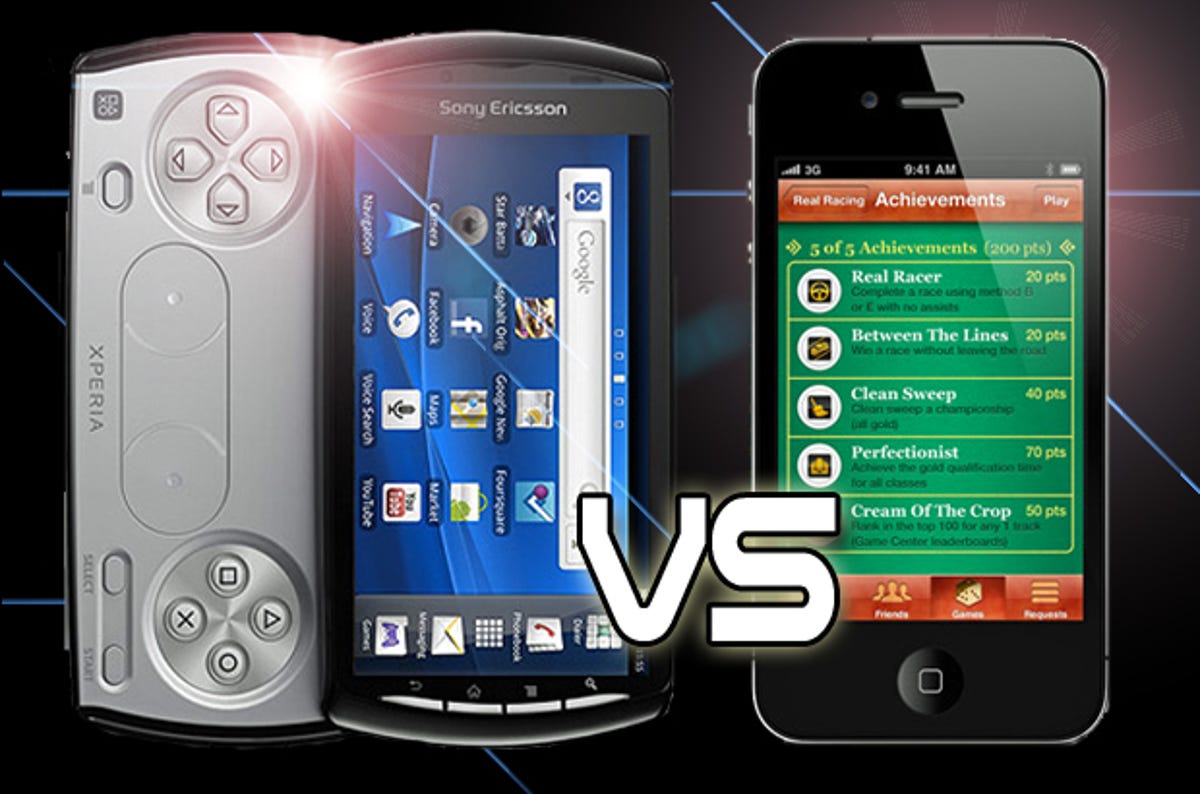
High-score hotshots assemble! The excellent Nintendo 3DS and the upcoming Sony NGP mean there’s never been a better time to gamify going out. But not everyone’s keen on lugging around a dedicated console, and with the Android and Apple app stores full to bursting with delicious downloadable games, many gamers are sticking with their phones.
The two front-runners in the mobile-gaming field right now are the Apple iPhone 4 and the Android 2.3-packing Sony Ericsson Xperia Play — aka the PlayStation phone. So if you’re in the market for a spot of thumb-knackering action, which phone should you choose?
Hardware head to head
The Xperia Play has PlayStation-esque buttons that slide out of the phone’s midriff specifically for gaming. There’s a direction controller on the left, four PlayStation face buttons over on the right, and two touch-sensitive trackpads in the middle that work rather like analogue sticks. There are left and right shoulder buttons around the edge of the handset, and if you were in any doubt that this is a phone built for gaming, there are Start and Select buttons stuck on for good measure.
There were many things we disliked about the Play when we gave it the full review treatment, but the physical buttons certainly weren’t on that list. These keys are comfortable and feel well made, and best of all they keep your fingers off the Play’s screen, so you can see what’s actually happening in-game without your thumbs obscuring your view.
The iPhone 4 has no such physical controls, but it doesn’t scrimp in the hardware stakes. Of particular note is the 3.5-inch, 960×640-pixel display that makes games look astonishingly crisp and clear. Take it from us: Angry Birds has never looked better.
The other thing to bear in mind is that the Play’s slide-out controls make it bulky, and very heavy. The iPhone 4 is extremely slender, and won’t drag your trousers down if it’s nestled in your pockets.
Gaming get-together
We tested a game available on both phones — Assassin’s Creed: Altair’s Chronicles by Gameloft, to see which mobile offered a better experience. On the Play, the physical controls felt really comfy, offering a greater degree of control and feedback than the iPhone 4’s touchscreen interface.
There were problems, however. There’s very little consistency with these physical controls across different titles, so we found the buttons didn’t always do what we thought they would. Assassin’s Creed makes use of just one of the touch-sensitive trackpads, and many other games don’t use them at all.
There are also exceedingly few games built with the Play in mind, so Assassin’s Creed, along with most titles available to download on the Play, had on-screen controls hogging valuable display space. Because all the games have either been built for touchscreen-only phones, or ported from other platforms, those on-screen instructions usually don’t correspond to the Play’s actual controls. This is true even of the classic PlayStation titles available to download.
In theory, the Play should be better for gaming, because the physical buttons offer greater control. In practice, however, these controls are so poorly implemented they usually feel wasted.
The Play also uses a couple of different apps for finding games, and doesn’t offer any way of searching what’s available, by genre or rating, for example. Downloading Gameloft titles will jump you into the browser and ask you to pay using PayPal or a service called Payforit, which charges the purchase to your phone bill. Compared to the iPhone 4’s App Store interface — centralised, blissfully simple and pretty fast — it’s a weak offering.
The price of games is another factor. We found many titles were more expensive to download on the Xperia Play. Assassin’s Creed will set you back £3, while the same title costs a mere 59p on the iOS platform.
Finally, much as we love Android, with more public focus on iOS we’re seeing more app development on that platform, and that definitely includes games. From the sublimely gorgeous Infinity Blade to the charming Tiny Wings and the mind-bending Trainyard, to date we’ve seen cooler, more creative and better-presented titles popping up for the iPhone than we have on Android.
Price perspective
The Xperia Play definitely has the iPhone 4 beaten on price. You can nab the Play for free on many contracts, for about £25-£35 per month. T-Mobile is offering the Play for £30 per month, for example, on an 18-month contract.
To get the 16GB iPhone 4 free upfront, you’ll have to pay around £45 on a 24-month contract, and if you want an 18-month contract for around £30 per month, be ready to shell out over £200 at the outset.
It might be cheaper than the iPhone 4, but we don’t think Sony Ericsson’s mobile matches Apple’s in terms of value. The Play is slightly less expensive, but it’s more than slightly worse than the iPhone 4.
Out for the count
The Play has the potential to be a far better gaming machine than the iPhone 4, because its mechanical buttons offer a degree of gaming control the iPhone can only dream of. The gaming offering on the Play has been so poorly implemented, however, we can’t recommend this phone, even to avid gamers.
Games for the Play are sparse and expensive, with little to no attention spared on optimising those titles for the phone’s physical controls. The gaming keypad feels good, but not good enough to outweigh these downsides. Sony Ericsson could fix these issues with a well-placed update — and games makers may release more compelling titles — but until this changes, this battle is very one-sided.
iOS gaming may be more simplistic, but it’s no less fun, and a wealth of affordable, inventive games in the App Store means the iPhone 4 is the best gaming phone around.



